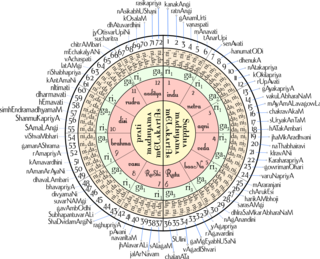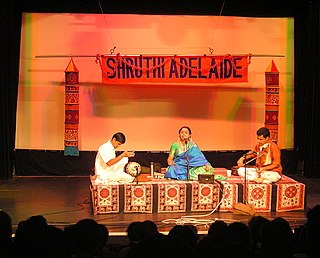
A raga is a melodic framework for improvisation in Indian classical music akin to a melodic mode. Rāga is central to classical Indian music and a unique feature of the tradition: no equivalent concept exists in Western classical music. Each rāga consists of an array of melodic structures with musical motifs; and, from the perspective of the Indian tradition, the resulting music has the ability to "colour the mind" as it engages the emotions of the audience.

Indian classical music is the classical music of the Indian subcontinent. It is generally described using terms like Marg Sangeet and Shastriya Sangeet. It has two major traditions: the North Indian classical music known as Hindustani and the South Indian expression known as Carnatic. These traditions were not distinct until about the 15th century. During the period of Mughal rule of the Indian subcontinent, the traditions separated and evolved into distinct forms. Hindustani music emphasizes improvisation and exploration of all aspects of a raga, while Carnatic performances tend to be short composition-based. However, the two systems continue to have more common features than differences. Another unique classical music tradition from Eastern part of India, i. e. Odissi music has evolved since two thousand years ago.

Ramtanu Pandey, popularly referred to as Mian Tansen, or Sangeet Samrat, was a Hindustani classical musician. Born into a Hindu Gaur Brahmin family, he learnt and perfected his art in the northwest region of modern Madhya Pradesh. He began his career and spent most of his adult life in the court and patronage of the Hindu king of Rewa, Raja Ramchandra Singh, where Tansen's musical abilities and studies gained widespread fame. This reputation brought him to the attention of the Mughal Emperor Akbar, who sent messengers to Raja Ramchandra Singh, requesting Tansen to join the musicians at the Mughal court. Tansen did not want to go, but Raja Ramchandra Singh encouraged him to gain a wider audience and sent him along with gifts for Akbar. In 1562, at about the age of 60, the Vaishnava musician Tansen joined Akbar's court, and his performances became the subject of many court historians.

The shruti or śruti is the smallest interval of pitch that the human ear can detect and a singer or musical instrument can produce. The concept is found in ancient and medieval Sanskrit texts such as the Natya Shastra, the Dattilam, the Brihaddeshi, and the Sangita Ratnakara. Chandogya Upanishad speaks of the division of the octave in 22 parts.
A Thaat is a "Parent scale" in North Indian or Hindustani music. It is the Hindustani equivalent of the term Melakartha raga of Carnatic Music. The concept of the thaat is not exactly equivalent to the western musical scale because the primary function of a thaat is not as a tool for music composition, but rather as a basis for classification of ragas. There is not necessarily strict compliance between a raga and its parent thaat; a raga said to 'belong' to a certain thaat need not allow all the notes of the thaat, and might allow other notes. Thaats are generally accepted to be heptatonic by definition.

Basant or Vasant is a Hindustani classical raga.

Bhairav is a Hindustani classical raga of Bhairav thaat. It is a sampurna raga that is traditionally performed in the morning and also as the beginning piece in concerts. It is the defining raga of its own Thaat.
Raga Bageshri or Bageshree is a Carnatic classical raga.It is a janya raga of the 22nd Melakarta raga Kharaharapriya. It is meant to depict the emotion of waiting for reunion with one's lover. Being a very melodic raga it has gained popularity over the centuries. In Hindustani music,it is said to have been first sung by Miyan Tansen, the celebrated court singer of the Emperor Akbar in the sixteenth century.

Abhogi is a raga in Carnatic music and has been adapted to Hindustani music. It is a pentatonic scale, an audava raga. It is a derived scale, as it does not have all the seven swaras. Ābhōgi has been borrowed from Carnatic music into Hindustani music and is also quite popular in the latter. In Hindustani music the raga has been classified under the Kafi thaat.
Bhimpalasi or Bheempalasi is a Hindustani classical raga.

Hamsadhvani, is a rāga in Carnatic music. It is an audava rāgam. It is a janya rāga of the Melakartha raga, Sankarabharanam (29th) but according to Hamsadhvani's prayoga or the way it is sung it is said to be the janya of Kalyani (65th).

Miyan ki Todi, often simply referred to as Todi or Darbari Todi, is a Hindustani classical raga which gave its name to the Todi thaat, one of the ten types of classical music according to the musicologist Bhatkhande. Ragas from the Todi raganga include Todi itself, Bilaskhani Todi, Gujari Todi, Desi Todi, Hussaini Todi, Asavari Todi, and Bahaduri Todi.

Tilang is a raga in Indian classical music, that belongs to the Khamaj Thaat.

Kāpi is a popular rāga in Carnatic music, the classical music of South India. Kāpi is a janya rāgam of Kharaharapriya with a meandering vakra scale. Typically performed at slow and medium speeds, it is capable of inducing moods of devotion, pathos and sadness in the listeners. Kāpi is different from the Hindustani raag and thaat Kafi. The equivalent raag in Hindustani is Pilu.

Shivaranjani or Sivaranjani is a musical scale used in Indian classical music. There are two scales, one in Hindustani music and one in Carnatic music. The Hindustani rāga is a pentatonic scale, as is the Carnatic scale categorized as Audava-Audava resulting in 5 notes in the Arohanam and 5 in the Avarohanam.
Durga is a raga in Hindustani Classical music. It shares some features with Shuddha Saveri of Carnatic music, but is significantly different from it in terms of the sancharas of the raga.
Bandish, cheez or gat is a fixed, melodic composition in Hindustani vocal or instrumental music. It is set in a specific raga, performed with rhythmic accompaniment by a tabla or pakhawaj, a steady drone, and melodic accompaniment by a sarangi, violin or harmonium. There are different ways of systematizing the parts of a composition. A bandish provides the literature element in the music, for standard structured singing. In the past many gharanas protected their bandishes from moving out of the family with gross incoherent vocal renditions. In the realm of vocal music, it is often known as cheez.

In Concert 1972 is a double live album by sitar virtuoso Ravi Shankar and sarodiya Ali Akbar Khan, released in 1973 on Apple Records. It was recorded at the Philharmonic Hall, New York City, in October 1972, and is a noted example of the two Hindustani classical musicians' celebrated jugalbandi (duet) style of playing. With accompaniment from tabla player Alla Rakha, the performance reflects the two artists' sorrow at the recent death of their revered guru, and Khan's father, Allauddin Khan. The latter was responsible for many innovations in Indian music during the twentieth century, including the call-and-response dialogue that musicians such as Shankar, Khan and Rakha popularised among Western audiences in the 1960s.
Dhani is a pentatonic raga in Hindustani classical music. It is a sprightly raga often described as Bhimpalasi sans the notes, Dha and Re. It however has its own distinct character. Dhani is frequently heard in popular music. This raga is also known as the romantic version of Raag Malkauns. It is similar to Malkauns, except that in the Aaroh and Avroh, Komal Dha is replaced by Pa in this raga
Gunakri is a raga in Hindustani classical music. Some consider it to be the same as the raga, Gunkali, while others consider the two to be distinct ragas. Gunakri is usually used in the khyal and dhrupad forms.










